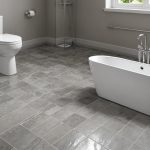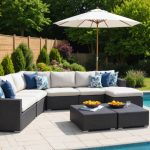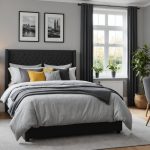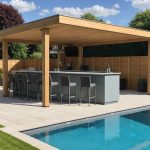Understanding Sleep Hygiene
Understanding sleep hygiene involves recognizing the practices and habits that contribute to a restful night’s sleep. At its core, sleep hygiene encompasses a set of behaviours and environmental factors aimed at improving sleep quality and ensuring restorative rest. Good sleep hygiene is vital for families as it can enhance overall health, boost mood, and improve cognitive functions.
The importance of sleep environment cannot be overstated. A conducive sleep setting includes factors such as comfortable bedding, a quiet atmosphere, and suitable temperature, all of which are crucial for achieving optimal sleep. Families should strive to create a peaceful environment, minimising disruptions and ensuring that the sleep space is reserved for rest and relaxation.
Topic to read : Choosing the Ideal Portable Air Conditioner for Your UK Summer Home Office: A Guide for Temporary Spaces
Poor sleep hygiene can significantly affect one’s health and well-being. Insufficient or disrupted sleep may lead to a range of issues including irritability, impaired memory, and even long-term health problems such as heart disease or obesity. Thus, prioritising good sleep practices and making necessary adjustments to the sleep environment are critical steps towards better mental and physical health for all family members. By implementing proper sleep hygiene, families can promote healthier, more productive lives.
Overview of Smart Technology for Sleep
In recent years, smart technology has opened new avenues for enhancing sleep quality, offering tailored solutions to meet individual and family needs. The sleep tech landscape is vast, with various devices designed to monitor, improve, and facilitate restful sleep. These range from simple sleep trackers and smart beds to advanced sleep apps and wearables that analyse sleep patterns for a personalised experience.
In parallel : Creating an Eco-Friendly Solar Lighting System: A Guide for UK Homeowners to Enhance Security and Beauty Outdoors
Each device has its own unique set of features. For instance, smart mattresses and pillows often include sensors to adjust firmness, while wearables may provide insights into sleep stages and offer feedback for improvement. Such technologies not only track sleep data but also utilise it to suggest lifestyle changes that promote better sleep.
As smart technology evolves, there is an increasing trend towards using AI and machine learning to predict and enhance sleep patterns. These advancements promise even more personalised solutions in the future, paving the way for smarter, more efficient ways to address sleep challenges. Understanding the functionalities and features of these devices enables families to make informed decisions, blending the benefits of technology with traditional sleep hygiene practices.
Integrating Sleep Trackers
Sleep trackers have become an essential tool for families aiming to optimise their sleep hygiene. These devices are designed to monitor sleep patterns, offering insights into different sleep stages and potential disturbances. By attaching comfortably to the body or placed on the bed, sleep trackers collect data on sleep duration, quality, and cycles, highlighting patterns that might affect rest and recovery.
The primary benefit of tracking sleep patterns is the ability to identify issues that could be hindering restful sleep. For instance, noticing disruptions can prompt adjustments in routines or the sleep environment, such as modifying room temperature or reducing bedtime screen exposure. Through detailed data analysis, families can pinpoint irregularities, making it easier to adopt changes that improve sleep hygiene.
Interpreting the data these trackers provide can guide families in taking actionable steps towards better sleep. Suggestions might include changing bedtime habits, adapting evening activities, or consulting sleep professionals if severe issues are detected. Embracing the information sleep trackers offer enables families to implement targeted strategies, further aligning with both traditional and tech-enhanced sleep practices. This informed approach leads to healthier, more rested households.
Utilizing Smart Lighting
Smart lighting plays a pivotal role in regulating the body’s natural sleep-wake cycles, or circadian rhythms. By adjusting light exposure throughout the day, smart lighting systems can help align your internal clock with natural light patterns, promoting healthier sleep routines. This is especially important in families where every member’s sleep needs must be synchronised.
When setting up smart lighting in bedrooms, it’s crucial to choose options that offer gradual dimming and cool light settings tailored for evening relaxation. Such configurations can signal the body that it is time to wind down, aiding in smoother transitions to sleep.
Exposure to certain types of light, particularly blue light, before bedtime, can significantly impair sleep quality. Blue light exposure can inhibit the production of melatonin, a hormone vital for sleep. Therefore, utilising options with warmer tones as you approach bedtime can mitigate these effects and enhance overall sleep hygiene.
Thoughtful integration of smart lighting not only fosters a conducive environment for rest but also supports routines vital for long-term sleep health. This technology, while sophisticated, is accessible enough to fit seamlessly into daily family life, enhancing both individual and collective sleep practices.
The Role of White Noise Machines
White noise machines have gained popularity as an effective solution for noise control, significantly enhancing sleep improvement efforts. Their functionality lies in producing a consistent and soothing ambient sound that masks disruptive noises, which can be especially beneficial in bustling households or areas with frequent disturbances.
These devices create a sound curtain, helping to block out unexpected noises such as traffic or neighbourhood disturbances, thereby fostering a more tranquil sleep environment. Families might find that the use of white noise aids children and adults alike, promoting uninterrupted rest.
Integrating white noise machines into bedtime routines can be simple and effective. For families with varying sleep schedules or babies who wake easily, these machines can provide continuous, comforting sounds. They help maintain a consistent auditory environment, which in turn may enhance overall family sleep hygiene.
Best practices include placing the white noise machine at a moderate distance from the bed to ensure comfort and prevent potential overreliance on sound. Incorporating white noise into existing sleep schedules may further support other healthy habits, leading to improved sleep quality for all family members.
Establishing a Tech-Enhanced Sleep Routine
Establishing a tech-enhanced sleep routine can significantly improve family sleep habits. To begin, identify and integrate suitable technology that complements traditional sleep hygiene practices. Smart devices, such as sleep trackers and lighting systems, can be tailored to regulate sleep-wake cycles effectively. Focus on creating a balanced routine by incorporating screen time moderation and mindful use of technology before bedtime to prevent overstimulation, thereby aligning technology use with natural sleep rhythms.
Family sleep habits are central to this routine. Encourage collective habits, ensuring that everyone in the household adopts a consistent sleep schedule. This consistency aids in reinforcing the body’s internal clock, enhancing both individual and collective sleep quality. To successfully integrate technology into sleep practices, families may consider setting specific times for technology usage and introducing shared activities, such as reading or meditation, to unwind before sleep.
In nurturing a harmonious balance between technology and sleep hygiene, maintain open discussions on its effects and adjust practices as needed. Through deliberate integration and sustained habits, families can foster an environment that supports restful sleep for all members, combining the benefits of traditional routines and modern innovations.
Benefits and Potential Downsides of Smart Technology
Smart technology offers numerous benefits when it comes to enhancing sleep quality. Devices like sleep trackers provide valuable insights into sleep patterns, helping families make informed decisions to improve their sleep hygiene. Features such as personalised feedback and actionable suggestions have empowered users to take control of their sleep health.
However, it is essential to consider potential drawbacks. Over-reliance on these devices can sometimes lead to anxiety about sleep, paradoxically affecting rest. Moreover, exposure to electronics late at night might disrupt natural sleep-wake cycles, highlighting the need for mindful use.
Despite these concerns, smart technology can still be part of a balanced sleep strategy. To maintain the benefits while minimising risks, one should focus on technology that complements existing sleep hygiene practices rather than replacing them. Making informed choices about which sleep devices to incorporate involves assessing personal sleep needs and preferences, alongside the functionality of available gadgets.
By doing so, families can make decisions that enhance sleep quality while maintaining a healthy relationship with technology, thus supporting a restful and fulfilling night’s sleep without unintended side effects.
Conclusion with Guidelines for Families
Utilising smart technology to improve sleep quality can greatly benefit family sleep routines. Embracing family sleep guidelines is crucial to optimising these technological solutions. Consider these strategies:
-
Tech Usage in Bedrooms: Introduce smart devices such as sleep trackers and smart lighting, while maintaining traditional sleep hygiene. Avoid over-reliance on tech by limiting screen time before bed.
-
Enhanced Sleep Quality: Combine smart technology with basic strategies such as a comfortable sleep environment and consistent sleep schedules to bolster rest.
-
Encourage Family Participation: Foster a shared commitment to creating an effective sleep routine by engaging all family members. Regular discussions about sleep technology use, alongside adjustments in routines, can reinforce the commitment without disrupting the balance.
-
Addressing Drawbacks: Remain mindful of potential disruptions caused by late-night tech use and its effect on natural sleep rhythms. Emphasise technology that complements existing practices.
-
Future Considerations: Stay informed on evolving sleep technology trends. As new advancements arise, reassess family needs and technologies’ effectiveness, ensuring continuous support for restorative sleep.
By thoughtfully integrating technology benefits while staying aware of potential pitfalls, families can cultivate a harmonious sleep environment that grows with their evolving needs.











